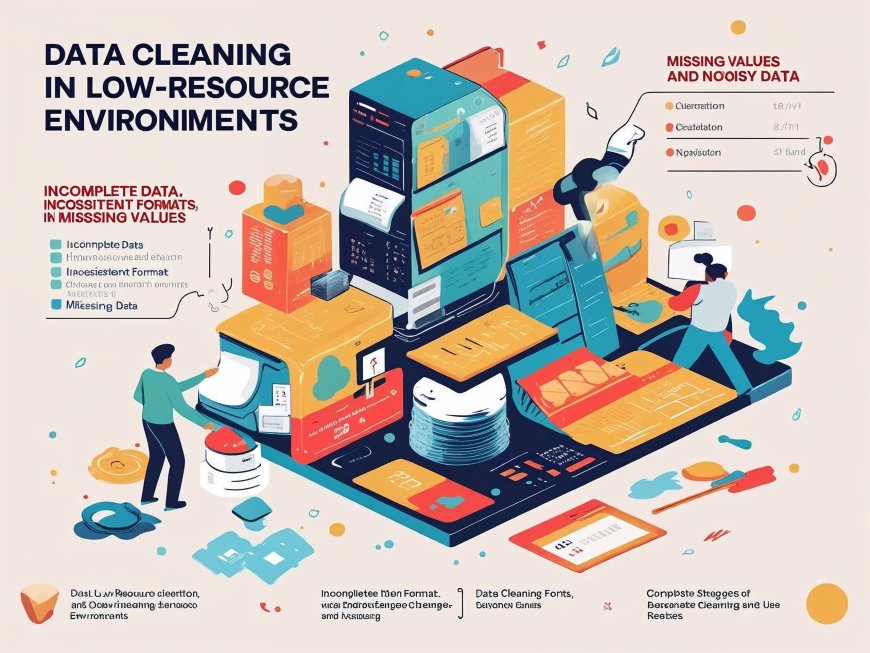Data Cleaning Challenges in Low-Resource Environments
This white paper explores the critical importance of data cleaning in low-resource environments, particularly in African healthcare systems. It highlights common issues such as missing data, inconsistent formats, and infrastructure gaps while offering practical recommendations for improving data quality.

Abstract
Data cleaning is an essential yet often overlooked aspect of digital health and public health analytics. In low-resource environments—where electronic health records (EHRs), surveys, and monitoring systems are fragmented and inconsistently maintained—dirty data can severely compromise decision-making. This white paper examines the technical, infrastructural, and human factors that contribute to poor data quality in African health systems and provides strategies for effective data cleaning in resource-constrained settings.
Introduction
As health systems across Africa rapidly digitize, the demand for reliable, high-quality data grows. However, incomplete, inconsistent, or inaccurate data often undermines the effectiveness of digital tools like decision support systems, predictive analytics, or disease surveillance platforms (WHO, 2021). In low-resource settings, these issues are compounded by poor infrastructure, understaffed facilities, and reliance on paper-to-digital transcription. Data cleaning—the process of detecting and correcting (or removing) corrupt or inaccurate records—becomes a critical yet underfunded activity.
Common Data Cleaning Challenges in Low-Resource Environments
1. Incomplete or Missing Data
-
Health workers may skip non-mandatory fields due to time constraints or low digital literacy.
-
Community-level data (e.g., from CHWs) often lack patient identifiers.
-
Lack of backup or recovery protocols leads to data loss during outages or sync failures.
2. Inconsistent Formats & Codings
-
Date formats may vary (e.g., DD/MM/YYYY vs. MM/DD/YYYY).
-
Diagnosis and drug names may appear as free text, abbreviations, or codes—without standardization (e.g., ICD-10, SNOMED CT).
-
Numeric data may be entered with different decimal separators or units (e.g., mg vs. g).
3. Duplicated Records
-
Patients without national IDs may be registered multiple times under different names or spellings.
-
Lack of deduplication tools within health information systems like DHIS2 or OpenMRS.
4. Infrastructure Constraints
-
Poor or unstable power/internet connectivity disrupts real-time syncing.
-
Devices may be shared across departments with conflicting workflows, creating version control issues.
5. Human Error & Training Gaps
-
Health workers under pressure may enter placeholder text (e.g., "N/A", "0", or "unknown") just to complete required fields.
-
Lack of ongoing training in digital literacy and data stewardship.
Example: A 2022 study in Nigeria found that 47% of entries in maternal health EMRs had at least one missing or inconsistent field (Adebayo et al., 2022).
Implications of Poor Data Cleaning
| Impact | Description |
|---|---|
| Skewed Analytics | Incorrect forecasting for supply chain or disease surveillance |
| Poor Clinical Decisions | Misdiagnoses or inappropriate treatment plans |
| Policy Misalignment | Misleading indicators lead to under- or over-resourcing |
| Wasted Investments | Donor-funded systems may fail due to unusable or unreliable data |
| Reduced Trust | Health workers and decision-makers may disregard insights from faulty data |
Best Practices & Tools for Data Cleaning in Low-Resource Settings
1. Use Structured Data Fields
-
Limit free-text inputs; use dropdowns, checkboxes, or radio buttons to reduce variability.
-
Adopt standard vocabularies (e.g., LOINC, ICD-10, SNOMED CT) from the start.
2. Implement Validation Rules
-
Auto-check for outliers, invalid dates, or missing mandatory fields before saving forms.
-
Use logic checks (e.g., pregnancy age range, impossible weight entries).
3. Train Local Data Stewards
-
Empower and upskill health workers or data clerks to clean data regularly.
-
Provide simplified checklists and dashboards for daily review.
4. Deduplication Algorithms
-
Deploy fuzzy matching tools or OpenMRS modules that flag duplicate patients using similarity scoring (name + DOB + location).
5. Leverage Offline-First Tools
-
Tools like OpenSRP, ODK, or CommCare allow for local data collection and validation before sync.
Tool Example: DHIS2’s built-in data quality app can flag anomalies in aggregate reports.
Source
Recommendations for Health Programs and Policymakers
-
Budget for Data Cleaning – Include ongoing data quality assurance in project design, not just tech procurement.
-
Make Data Cleaning Collaborative – Involve clinicians, data officers, and IT in regular quality reviews.
-
Reward Good Data Practices – Use dashboards to showcase high-quality facilities and motivate improvement.
-
Build for Local Context – Tools and validation logic should be adapted to community-level health realities.
-
Support a Data Culture – Encourage a shift from “just entering data” to “using data for action.”
Conclusion
Data cleaning is the unsung hero of effective health systems—especially in Africa’s low-resource settings. Without it, digital health efforts risk collapse under the weight of unreliable information. By adopting low-tech best practices, standard tools, and targeted training, stakeholders can significantly enhance data quality and unlock the true potential of digital health investments.
References (APA 7th Edition)
Adebayo, A., Ojo, T., & Olagoke, A. (2022). Data quality assessment of maternal health electronic records in Nigeria. African Journal of Health Informatics, 12(2), 43–51. https://doi.org/10.4314/ajhi.v12i2.5
World Health Organization. (2021). Data quality review: A toolkit for facility data.
https://apps.who.int/iris/handle/10665/340625
HISP. (2023). Data validation and quality assurance in DHIS2.
https://docs.dhis2.org/en/use/data-quality/index.html
Digital Square. (2020). Improving health information systems in low- and middle-income countries.
https://digitalsquare.org/resources
What's Your Reaction?
 Like
0
Like
0
 Dislike
0
Dislike
0
 Love
0
Love
0
 Funny
0
Funny
0
 Angry
0
Angry
0
 Sad
0
Sad
0
 Wow
0
Wow
0



















































